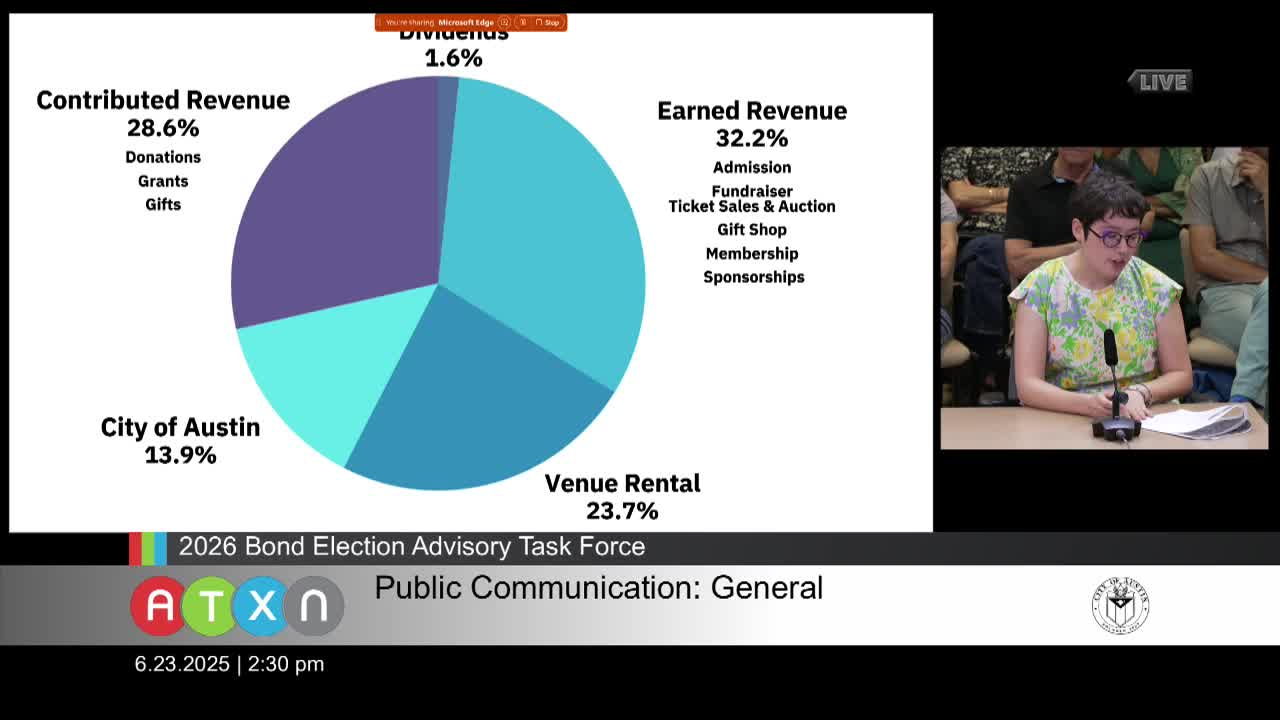Umloff Museum launches historic preservation plan for Austin's iconic site
June 23, 2025 | Austin, Travis County, Texas
This article was created by AI summarizing key points discussed. AI makes mistakes, so for full details and context, please refer to the video of the full meeting. Please report any errors so we can fix them. Report an error »

A bold vision for the future of the Umloff Sculpture Garden and Museum is taking shape, as the Austin City Council considers a comprehensive plan to enhance accessibility and preserve the historic site. Amanda Volbrack, the director of operations, unveiled the Historic Preservation, Expansion, and Unification (HPEU) plan during a recent meeting, emphasizing its potential to transform the iconic property into a fully accessible cultural hub for all Austinites.
The plan, developed in partnership with Page Architecture Firm, aims to unify the 8-acre site, which includes the historic home and studio of Charles and Angie Umloff, gifted to the city in 1985. Currently, the historic homestead remains closed to the public due to accessibility challenges, as it sits 45 feet above the sculpture garden. The proposed solution includes a new building, dubbed "The Treehouse," equipped with an elevator to connect the garden to the homestead, ensuring that visitors can experience the full breadth of the Umloff's artistic legacy.
Volbrack highlighted the importance of addressing environmental concerns as well, detailing strategies for stormwater management and the restoration of overgrown areas on the property. The plan also includes creating a "Natural Zone" with educational trails, which would reclaim two acres of parkland for community use.
Community engagement has been a cornerstone of the planning process, with feedback indicating strong support for preserving the site and enhancing its accessibility. The HPEU plan has already received endorsements from multiple city boards and the Zilker Neighborhood Association, reflecting a collective commitment to cultural preservation and community access.
As the city moves forward, funding sources for the project will include historic preservation grants, private donations, and a request for support from the upcoming 2026 city bond election. The Umloff Sculpture Garden and Museum Non-Profit will continue to manage operations, ensuring the site remains a vibrant cultural asset for Austin.
With the HPEU plan poised for implementation, the city is on track to not only preserve a unique piece of Austin's artistic heritage but also to create a welcoming space that fosters community engagement and environmental stewardship.
The plan, developed in partnership with Page Architecture Firm, aims to unify the 8-acre site, which includes the historic home and studio of Charles and Angie Umloff, gifted to the city in 1985. Currently, the historic homestead remains closed to the public due to accessibility challenges, as it sits 45 feet above the sculpture garden. The proposed solution includes a new building, dubbed "The Treehouse," equipped with an elevator to connect the garden to the homestead, ensuring that visitors can experience the full breadth of the Umloff's artistic legacy.
Volbrack highlighted the importance of addressing environmental concerns as well, detailing strategies for stormwater management and the restoration of overgrown areas on the property. The plan also includes creating a "Natural Zone" with educational trails, which would reclaim two acres of parkland for community use.
Community engagement has been a cornerstone of the planning process, with feedback indicating strong support for preserving the site and enhancing its accessibility. The HPEU plan has already received endorsements from multiple city boards and the Zilker Neighborhood Association, reflecting a collective commitment to cultural preservation and community access.
As the city moves forward, funding sources for the project will include historic preservation grants, private donations, and a request for support from the upcoming 2026 city bond election. The Umloff Sculpture Garden and Museum Non-Profit will continue to manage operations, ensuring the site remains a vibrant cultural asset for Austin.
With the HPEU plan poised for implementation, the city is on track to not only preserve a unique piece of Austin's artistic heritage but also to create a welcoming space that fosters community engagement and environmental stewardship.
View full meeting
This article is based on a recent meeting—watch the full video and explore the complete transcript for deeper insights into the discussion.
View full meeting
